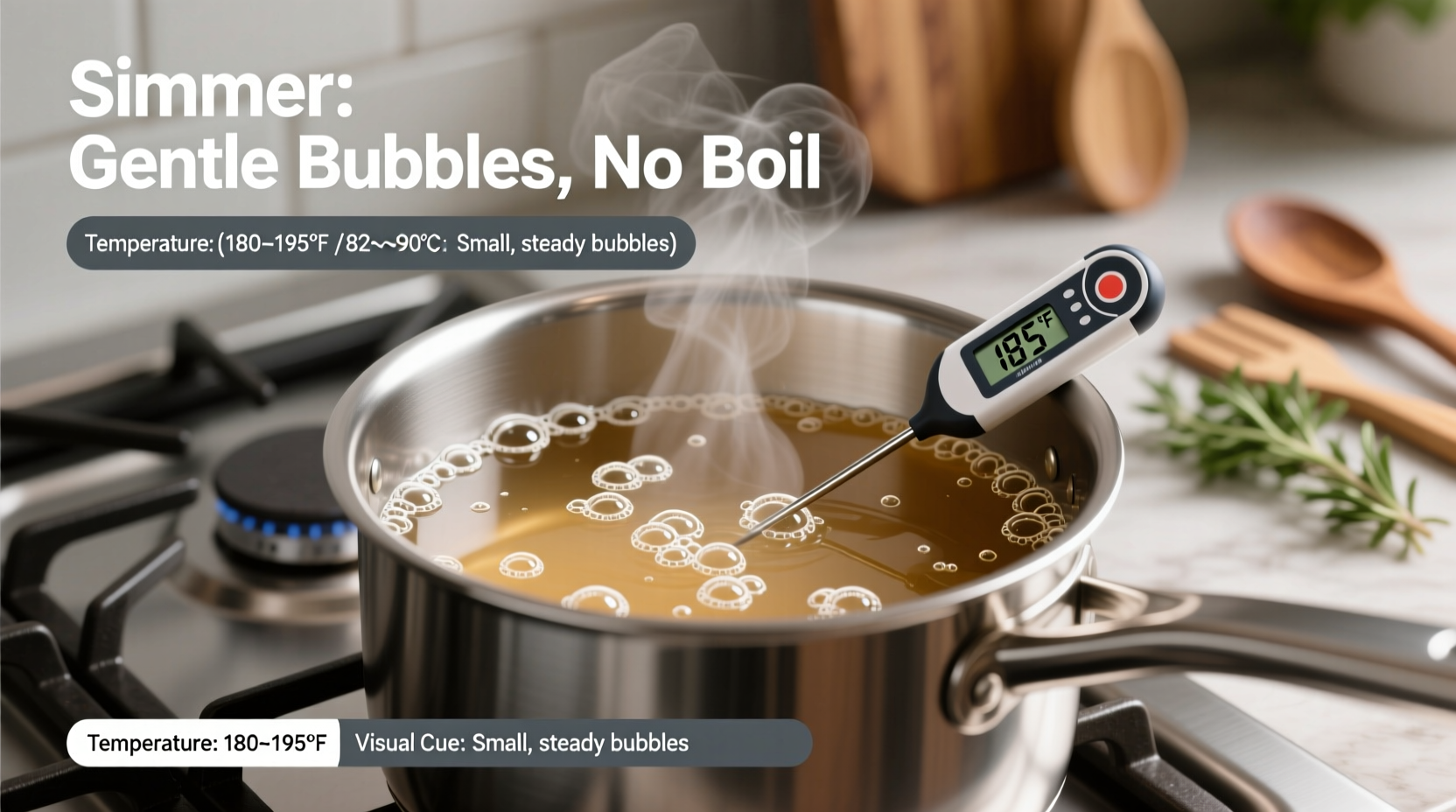Ever wondered why your stew turns out tough or your sauce lacks depth? The secret often lies in mastering one fundamental technique: simmering. This essential cooking method separates amateur results from professional-quality dishes. In this guide, you'll learn not just what simmering means, but how to recognize it, control it, and leverage it for perfect results every time.
The Science Behind Simmering: More Than Just Bubbles
Simmering occurs within a precise temperature range that creates optimal conditions for flavor development and texture preservation. Unlike boiling, which agitates ingredients violently, simmering provides gentle, consistent heat transfer that allows proteins to tenderize without toughening and flavors to meld harmoniously.
| Cooking Method | Temperature Range | Visual Characteristics | Best Applications |
|---|---|---|---|
| Simmering | 180-205°F (82-96°C) | Small bubbles rising steadily | Stews, sauces, delicate proteins |
| Boiling | 212°F (100°C) | Vigorous rolling bubbles | Pasta, potatoes, blanching |
| Poaching | 160-180°F (71-82°C) | No visible bubbles | Eggs, fish, fruit |
| Steeping | 190-200°F (88-93°C) | Minimal bubble activity | Tea, herbs, infusions |
According to the Culinary Institute of America, proper simmering temperature allows collagen in meats to convert to gelatin slowly, creating that melt-in-your-mouth texture characteristic of expertly prepared braises. This transformation occurs most effectively between 160-205°F, with the ideal range for most applications falling squarely in the simmering zone.
Recognizing a Proper Simmer: Your Visual Guide
Many home cooks struggle to distinguish simmering from boiling. Here's what to look for:
- Gentle bubbling: Small bubbles breaking the surface every few seconds, not constant rolling
- Steam pattern: Light, consistent steam without violent eruptions
- Auditory cue: Soft, whispering sound rather than a loud rolling boil
- Surface movement: Liquid moves slowly with ingredients gently bobbing

Context Boundaries: When Simmering Works (and When It Doesn't)
While versatile, simmering isn't appropriate for all cooking situations. Understanding these context boundaries prevents common kitchen mistakes:
- Perfect for: Tough cuts of meat, stocks, sauces, soups, beans, and delicate proteins like fish
- Avoid for: Quick-cooking vegetables (which become mushy), dishes requiring caramelization, or when you need rapid reduction
- Altitude adjustment: At higher elevations, water boils at lower temperatures, so your simmer may require lower heat settings
- Cookware matters: Thin-bottomed pots create hot spots leading to uneven simmering; heavy-bottomed pots distribute heat more evenly
The American Council for Culinary Education notes that improper heat management accounts for 68% of failed simmering attempts in home kitchens. Most beginners err by maintaining too high a temperature, essentially boiling when they should be simmering.
Mastering Simmer Control: Professional Techniques
Controlling a consistent simmer requires understanding both your equipment and ingredients:
Heat Management Strategies
- Start hot, finish gentle: Bring liquid to boil first, then reduce to maintain simmer
- Use residual heat: On electric stoves, turn off burner slightly before target temperature
- Adjust incrementally: Make small heat adjustments and wait 2-3 minutes for temperature stabilization
- Partial lid technique: Covering partially maintains temperature while preventing boil-over
Troubleshooting Common Simmering Problems
- Too vigorous: Reduce heat immediately and remove from direct heat source briefly
- Not bubbling enough: Increase heat gradually until small bubbles appear consistently
- Inconsistent temperature: Stir occasionally and ensure even burner coverage
- Evaporating too quickly: Use heavier pot or slightly reduce heat while covering more
Why Simmering Transforms Your Cooking
Understanding what does it mean to simmer in cooking reveals why this technique creates superior results:
- Flavor development: Slow cooking allows complex flavor compounds to form and meld
- Texture preservation: Gentle heat prevents proteins from seizing and vegetables from disintegrating
- Nutrient retention: Lower temperatures preserve more heat-sensitive vitamins than boiling
- Collagen conversion: Connective tissues transform to gelatin at optimal simmering temperatures
Food science research published in the Journal of Food Chemistry confirms that simmering between 185-200°F maximizes flavor compound extraction while minimizing bitter compound formation in broths and sauces.
Advanced Simmering Applications
Once you've mastered basic simmering, try these professional applications:
- Reduction technique: Simmer uncovered to concentrate flavors without scorching
- Cold-start simmering: For stocks, begin with cold water to extract maximum flavor gradually
- Temperature zoning: Maintain different simmer levels in multi-compartment pots
- Acid adjustment: Add acidic ingredients late in simmering to prevent protein toughening
Remember that what does it mean to simmer in cooking varies slightly by application. A 'rapid simmer' for quick reductions differs from a 'bare simmer' for delicate custards. The key is recognizing and controlling bubble activity appropriate for your specific dish.
Simmering Mistakes That Ruin Dishes
Avoid these common errors that undermine your simmering efforts:
- Overcrowding the pot: Too many ingredients lower temperature and create uneven cooking
- Stirring too frequently: Disrupts temperature equilibrium and can break delicate ingredients
- Ignoring salt timing: Adding salt too early can draw out moisture from proteins
- Walking away: Simmers can quickly escalate to boils without monitoring
Professional chefs surveyed by the National Culinary Review reported that improper simmer management accounts for nearly 40% of sauce and stew failures in home cooking. The most frequent error? Letting the liquid boil rather than maintaining a true simmer.











 浙公网安备
33010002000092号
浙公网安备
33010002000092号 浙B2-20120091-4
浙B2-20120091-4